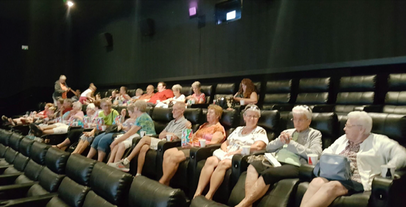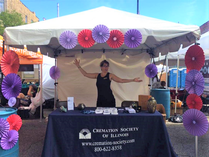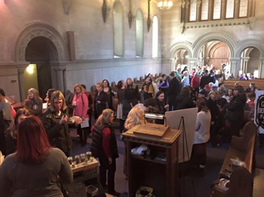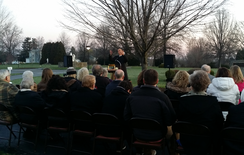|
If you're reading this, chances are your deathcare firm is already present on at least one social media channel. If I had to guess, I'd say it was Facebook (and I'd put my odds of being correct pretty high). You might also be on one other major site, such as Instagram. If that's the case, good calls from your marketing teams. Even with some rough patches in 2019 and 2020, Facebook remains the biggest social media platform in America based on number of users. Plus, it's the most popular with middle-age and older adults, who account for most deathcare decision-makers. Instagram comes in second based on user numbers, and a growing number of adults age 35 and up are joining this channel. That makes it a good choice for cremation providers that can manage two social media pages. But what about all the other options? Are you missing out on deathcare social media marketing opportunities because you're ignoring platforms such as Twitter, Snapchat, TikTok, Pinterest, or Tumblr. Get some details on these social channels below so you can decide for yourself. If I asked an average American adult to name three social media channels, they'd probably say "Facebook, Instagram, and Twitter." Twitter comes in third behind the other two when it comes to user numbers, and its user demographics are relatively spread out across age groups from 18 to 64. The challenge in marketing on Twitter is the fast-paced environment. Short posts of 280 characters or less inundate most people's Twitter feeds, sometimes dozens or even hundreds per minute. That can make it hard for businesses to connect with people on the platform. It's not that Twitter is impossible to market on. You just have to be persistent, consistent, and sometimes clever to make it work for your cremation services firm. snapchat More than 200 million people log on and use Snapchat daily, with active users opening the app an average of 30 times a day. That's a lot of opportunity for engagement and micro-moment marketing (that's when you connect with potential clientele in those stolen moments when they look at their phones). The downside of Snapchat for deathcare marketing is that the bulk of the userbase is under the age of 34 . There might be some benefit to growing audiences early, and certainly some younger people do make deathcare decisions. But most deathcare firms aren't going to find their main target audience here. tiktokA relatively new contender, TikTok reports around 100 million users in the United States. Around 62 percent of those users are under the age of 29, which means this social site has the same drawbacks as Snapchat when it comes to demographics. However, the users on TikTok are highly engaged , spending an average of 40 minutes a day or more on the platform. It's easy to make TikTok videos, which only require a smartphone. And you can use the video you make on TikTok to add video content to other deathcare marketing channels, including Facebook, Instagram, or even your blog. Pinterest is an image-sharing platform. Users make boards and "pin" images (and related links) to them. The idea is that Pinterest acts as a virtual corkboard, and as you travel around the internet, you can collect things of interest by pinning them to these boards. Deathcare firms can create their own boards, pinning things of interest for their audience, including blog posts, landing pages for downloads, or images of products. The bulk of Pinterest users—about 70 percent—are female. While the majority of users are under age 40, the median age of users is 40. That means there's a decent number of middle-age and older users. Pinterest is fairly easy to manage, which might make it something deathcare firms can do here and there without a big commitment. You may also be able to get some boost from Pinterest traffic without having a profile and boards for your business. Simply create infographics and other images that would entice people to pin them on their own boards. tumblrTumblr is a personal blogging site that makes it easy for people to post their own thoughts, writing, and art or share (called reblogging) the posts of others. The majority of Tumblr users are under the age of 35. While Tumblr might be a way for cremation providers to reach younger audiences, it's not really known for being a strong marketing channel outside of unique cases. THE BOTTOM LINE ON "OTHER" SOCIAL MEDIA SITESUltimately, what works well for your deathcare firm depends on your business needs, brand, and where your target audience is. Most deathcare firms should have a presence on Facebook in 2021, but if you have the marketing resources to add one or two other channels while maintaining quality, you might want to test some of these other options. Just don't be afraid to move on if the channel ends up doing nothing for you. Better to invest that time and money into channels that are performing than to stick with something just because you started it.
It’s no secret successful digital marketing takes time and planning. Funeral professionals encounter obstacles ranging from lack of time to budget considerations to limited marketing experience or know-how when planning their digital strategy. Add in the ever-changing digital landscape and it can make for a big mountain to climb. That’s why many funeral homes and cemeteries often look for a marketing professional or agency to do all or some of their marketing. However, some firms find choosing the right partner a bit daunting and aren’t even sure what questions they should ask when interviewing prospective marketing partners. We crafted this list of questions to help people identify which partner is right for you, your firm, and your goals. Answers to these questions before you hand off your digital marketing to an outside marketing company will help you understand just what you’re getting into. If you’re in the process of choosing someone to handle your marketing, or if you are working with someone already, you likely know three things for sure:
Use this list of questions during your next meeting with a current or potential marketing agency to help you evaluate what you are getting when you partner up. 1. Can I get a comprehensive list of what I get for the monthly fee or any one-time fees? This answers the big question: “What am I getting for my money?” You want to know exactly what you’re expected to handle, and what your marketing company is taking off your hands. The more clearly your marketing company can explain what they need from you, what the next steps are, and what you can expect from them, the greater chance they will be the right fit for you. For instance, will your marketing company provide you content but you need to post it? Or do you need to provide content and they post it? How often do they post? Once you get a comprehensive list of items included with the service, consider asking the follow-up questions below.
There are no right or wrong answers here. You just want to have a clear understanding so you can better assess what you are getting for the money you pay. Our experience is that fewer surprises lead to happier relationships. Once you have the answers, you can better analyze if the prospective marketer is a good fit for you. 2. Can you explain these items in terms I can understand? Once you get the terms, make sure you understand what they mean. If you don’t understand the marketing jargon being used, your marketing company should be able to explain it to you in a way you can understand. What you’re looking for here isn’t an MBA in a 30-minute phone call, but transparency. Is your prospective marketing company willing to spend a little time helping you understand? Do they understand themselves or have someone on staff who does? Can they define terms you don’t know? Give appropriate analogies to help you see what they mean? Talk about the process you will go through with them? Help educate you on how everything works? You want to see a willingness from the marketing team to help you understand, especially at the beginning of the relationship while you are building trust with the partner. 3. What short-term gains can I expect once I start using your service and what is your strategy to get me there? When looking at overall business health, it’s important to have short-term and long-term goals for your firm. A short-term goal is something you want to accomplish today, this week, this month, or even this year. Your short-term goals should help you reach your long-term business goals. Do the short-term objectives and tactics fit with your long-term plans? For instance, does the short-term plan enhance your brand, help you get ahead of the competition, build your reputation (or at least not detract from it), etc. Be sure that the gains your marketing company says it will provide fit with your business goals. No need to have a preneed strategy if you’re not interested in more preneed growth, for example. 4. What long-term gains can I expect and what is your strategy to get me there? Long-term goals require time, planning, and an effective strategy. Be clear with your marketing company on what your long-term business goals are. Then ask what gains you can expect in the long term that support those goals. As mentioned above, your short-term objectives should help you reach your long-term ones. If you are unclear about what your business goals are, what marketing goals you should have, and what gains you can expect based on the strategy and tactics used, ask your marketing company to help you. Most marketing companies have plans or offerings that include strategy sessions to help you tease out what you want for your business and know how to create a marketing strategy to help get you there. 5. What data tracking do you offer and how do I access it? You’re looking for transparency from your marketing partner. You should know exactly how posts are performing, how the company is checking, how you can check, and who will be answering your questions about the results. You’ll want to know how that performance directly relates to your business results. You’re not looking for “perfect” results here; there’s really no one “perfect” result. You do, however, want to see how the efforts are performing and be able to see the results yourself to determine what’s working and what’s not. 6. Who owns the email domain, website domain, and content? Why do you want to know this? Because if you decide to part ways with a marketing company in the future, you need to know what’s yours and what’s theirs. If you own the rights to your email and website domain, then you can make future updates to them on your own or through a future marketing or website provider. As for content, if it’s a reputable company they should have a solid (and legal) method of obtaining images for your content. No sketchy shortcuts here. And they should be able to tell you what content you get to keep if you end the partnership and which content is theirs. Like your email domain and website, there are several reasons you want to know what sort of access you have to your content. For starters, if the marketing company is custom-creating your content, can you still use it after your contract expires? Say they create a post to promote your 2021 event and you want to use it again for the 2022 event, are you going to run into trouble reusing the posts they created for you, or is that content all yours? There’s no right or wrong answer, just look for a clear response so you are aware of the process. Next, when running lead ads, will you have access to the contacts collected, or is there an extra charge for contacts? You might also ask if the marketing company keeps or sells the contacts collected. You want access to those leads and their contact info, so be sure to address that question. 7. How much work does your plan require on my part or from my staff? As mentioned above, you need a clear understanding of what your marketing company is taking over and what you still handle. You should also find out how much time they need from you on a daily, weekly, or monthly basis. We recommend you cover this upfront so there are no surprises. Every marketing company or partner is going to need some of your time for things like collecting logos, access to websites or Facebook pages, strategy setting, content approval, and more. Just like onboarding an employee, an upfront commitment is required but will pay dividends in the long run. The key here is to gain an understanding of how much time that will take. Note that more time may be needed at the beginning of the relationship as you and your marketing partner get to know one another. Don’t be afraid to ask if this time requirement will decrease over time or remain consistent. 8. What is your onboarding and customer service like? Onboarding isn’t an overnight process. It requires time and effort from both you and your marketing company. Investing your time and effort with the right company will ultimately result in more preneed contracts, at-need business, and an established online presence. Onboarding takes time, but your marketing partner should have a process. Be sure to ask how long they estimate it will take. You may be in a time crunch or you may have all the time to launch your online strategy; find a marketing company that can provide what you need in the time you need it. Once you know your onboarding timeline, ask about their communication process. Find out:
What kind of customer support can you expect? Depending on your preferences, you can choose to work with a marketing company that sends check-ins and reports or with one you interact with daily. Those options and more are out there, just ask so you can choose what works for you. 9. Do you have an internal team that creates my website, Facebook posts, and other materials for my funeral home or cemetery, or do you outsource these things? Selecting an agency that has in-house experts across their service offerings is a good idea for a few reasons. You have someone in-house to collaborate with and you can maintain a consistent relationship with less of the “relearning” that happens than with one-off workers. Some marketing companies use freelancers and that’s ok! As long as there is an in-house expert to help you when you need something immediately addressed. 10. What security practices do you follow to keep on-file payment information safe? With all the ways personal information can be stolen online, you want to be sure your marketing agency is handling digital information securely. During your next meeting with your marketing company ask these questions to ensure any personal information is kept safe:
Don't settle - before you hire a marketing agency find out who they are, what sets them apart, and how they plan to help your firm grow. We know selecting a marketing agency to work with can seem both intimidating and overwhelming. We hope this guide helps you confidently select the right marketing company for you. You can find more useful resources and information by visiting the Funeral Innovations website and blog under the resources tab: www.funeralinnovations.com. Want a chance to chat about these topics and more? Alex McCracken, Funeral Innovation’s VP of Sales, joins the Crucial Conversations Series to discuss how to reach people digitally no matter where they are, from preneed to aftercare. On Wednesday, April 14, he’ll be joined by other experts to facilitate conversations on Pandemic Lessons on Preneed and Aftercare, learn more here. Registration is free for CANA Members and just $15 for non-members, and includes 1 hour of CE from the Academy. Not a member yet? Check out more benefits of joining CANA and learn why our association keeps growing: goCANA.org/WhyJoinCANA
More than 90 percent of online experiences for consumers start with a search engine. Whether these consumers tap on their phone to query Siri or type a key phrase into Google's browser bar, the result is the same for your deathcare firm. If you're not drawing a clear line between search engine results pages and your own website or offers, you're missing out on revenue opportunities. This is one reason content is king—and has been for years. But it's no longer enough for content to don a crown and hold court over your marketing strategy. The king has lots of competition for search engine optimization, and if neighboring kingdoms (aka your competitors, if you're still humoring this extended metaphor) are generating better quality content, your SEO performance could suffer. And by "suffer," I mean your pages won't show up at the top of the search results—or potentially at all. Which means you have less of a chance of connecting with people who might be interested in cremation and related services now or in the future. What's a king to do about this conundrum? Luckily, Google itself publishes a battle plan that helps you create high-quality content that's more likely to perform in Search Engine Results Pages or SERPs. It's called the Search Quality Evaluator Guidelines. WHAT ARE SEARCH QUALITY EVALUATOR GUIDELINES?Google publishes these guidelines for its human search quality evaluators. Actual humans (yes, that's rare these days) review pages to determine whether they meet the needs of a potential search in a high-quality manner. The higher a page is rated by evaluators, the higher it might potentially rank in search results. Evaluator scores aren't the only thing used to rank a page—Google algorithms are complex, after all. But the evaluator guidelines do provide important clues into exactly what Google considers important when it comes to content PAIRING GOOGLE GUIDELINES DOWN TO A SUCCESSFUL CONTENT FORMULAThe guidelines comprise roughly 170 pages of small text, which is obviously a lot of information to get through. But you don't have to read everything in the evaluator guidelines to understand how to create great cremation services content. Consider this quick formula for high-quality content from Google: Purpose + E-A-T = Quality PAGES MUST HAVE A PURPOSE High-quality content serves the purpose of the page. If your page doesn't have a purpose (which might be to inform, entertain, or assist readers), the content can't be high quality. Or as Google puts it, pages "created with no attempt to help users, or pages that potentially spread hate, cause harm, or misinform or deceive users, should receive the lowest [quality] rating." REMEMBER THE E-A-T ACRONYM When pages do have a positive purpose, Google rates the quality of their content according to "E-A-T." The acronym stands for expertise, authority, and trustworthiness. Per Google, E-A-T content…
WHAT ELSE DOES GOOGLE SAY ABOUT HIGH-QUALITY CONTENT?Google likes the word satisfy. It appears in the evaluator guidelines more than 130 times in various forms. A high-quality page satisfies the needs of the searcher and the promise you made in meta descriptions and headings. If you promise a complete guide to preplanning, your content should certainly be more than 500 words and cover all the questions someone has about that topic. If your link is a buy link for an urn, the page should include everything a person needs to make a final purchasing decision. The shopping cart process and customer service options should also satisfactorily meet the needs of your cremation clientele. Ultimately, Google's SERPs have one job, and that's to match searchers with pages that best meet their needs. By creating high-quality content that follows the above formula, you increase the chances that Google thinks your page is a good bet for the relevant keyword searches. In turn, that increases your chances at winning the click, driving more traffic, making more sales, and proactively competing with the other kingdoms in your niche.
Consumers have driven the popularity of cremation and funeral directors, cemeterians and crematory operators are doing their best to keep up with demand. In May 2019, Homesteaders Life Company and CANA set out to explore a consumers’ experience with cremation from women who personally made the arrangements for a loved one. Our goal was to explore beyond multiple choice responses to get to the question “Why?”. When we dig down to uncover motivations for their decisions, we can attempt to understand their experience from beginning to end. Put simply, we sought to better discover the cremation experience.
We listened to the perspectives of several groups over the course of three months. All participants were Baby Boomer-aged women living in Phoenix, Arizona or Nashville, Tennessee who were arranging a cremation for the first or second time. As the women described their cremation experiences, they realized that they often had very different experiences and learned from each other. They expressed a desire for more information or education about cremation, since this was often a new tradition in their families. There were many insights gleaned during the focus groups, but we are highlighting just a few in this post that stand out.
1: Consumers Want More Education
The focus group participants raised several questions, many of them related to handling of “ashes.” Participants suspected some rules existed, but weren’t sure what the rules were or where to find them. In general, the women tended to do what they wanted, but they carefully watched over their shoulder just in case it was improper – or even illegal. That is definitely not the best cremation experience.
Often, these women learned from friends or their own experiences rather than having a go-to resource. Google was mentioned more than once as a starting place to research information on cremation options. Many women noted that they were pretty familiar with “traditional funerals” but that they weren’t as knowledgeable about what cremation entailed. It’s a newer tradition, and they felt that not as much information is available to help them understand the process.
Where did these families get ideas for the service? The internet. Where did they find a cremation provider? Mr. Google. They didn’t have to wait to sit down with a funeral director to get a price list of goods and services. They researched online and put together a preliminary budget well before meeting at the funeral home.
If they didn’t like the urns or jewelry on display in the arrangement room, they turned to – you guessed it – the internet: Amazon, Etsy, Walmart, and other retailers they know and trust that feature product reviews and recommendations on these keepsakes they probably haven’t bought before. Not one woman described returning to the funeral home to purchase cremation jewelry or an urn after the service. This was qualitative research, and not quantitative, so it is possible that many families do return to the funeral home for merchandise, but this research did not suggest that is common.
So what’s a local cremation provider to do? You may want to consider additional ways to reach out to consumers and help them understand all of the options available for service and memorialization. Be the expert in cremation. Become the trusted information source in your community. Don’t be afraid to talk about cremation and the options it provides. Consumers will choose cremation whether you talk about it or not. It’s better to be the expert than leave the consumer to figure it out without you.
2: Language Matters
Funeral professionals speak a different language than cremation consumers. Over the years, funeral professionals and society decided that euphemisms were gentler and kinder.
But sometimes euphemisms are confusing and the situation demands specific language to describe a process or professional practice. Death care, much like other professions, has developed its own jargon to describe its work, particularly with cremation to establish its differences to burial and related practices and products. However that jargon may be confusing rather than increasing understanding when talking with consumers.
How can we connect with consumers if we are speaking different languages? The table below highlights some of the language disconnects uncovered during the research.
This language disconnect was painfully obvious from the first minutes of the first focus group. The most common example is one of the most common terms in cremation: “ashes.” Today, mortuary science and funeral service students are taught the terms “cremated remains” and “cremains”, which are also widely used by funeral professionals. And yet not one single focus group participant used any term other than “ashes.”
In the arrangement room, funeral professionals rarely correct a consumer they are serving, but rather translate “ashes” to “cremated remains” in their head, or simply mirror the language used by grieving family members to provide comfort and promote understanding. But what about a website or other marketing materials? Should written consumer-facing language use common terms like “pick up the body” instead of “first call” to build common ground and understanding? More and more death care providers are doing so for reasons ranging from SEO to increasing sales.
3: Preplan Please
The focus group participants quite unexpectedly raised a particular topic on their own: preplanning. Preplanning, advance planning, prearranging – whatever you like to call it – was never part of the research’s list of topics to explore. Nevertheless, it was something the women brought up during the “Queen for a Day” exercise that occurred near the end of each focus group.
The participants were crowned “Queen for a Day” and asked to issue a decree. They could make any change they wanted and the whole world would have to follow their order. This was intended to encourage them to describe their ideal cremation experience. Not surprisingly, the most common decree was to bring back their loved one. The second most common request, however, was a complete surprise: they decreed that everyone preplan, prepay and discuss their wishes with their family member in advance.
Why was preplanning so important to these women? Like many family members, they wished they would have known more of the details their loved one wanted for their celebration of life. While they may have known their loved one wanted to be cremated, they may not have known much more than that. What about a venue? What about musical selections or special readings? What about thoughts on what to do with the “ashes” after the ceremony?
Perhaps if the women had known more about the “new” tradition of cremation they would have tried to ask their loved one more questions. Better yet if their loved one had preplanned, those questions would have naturally been raised and answered. What a relief the focus group participants would have felt knowing that they were fulfilling all of their loved one’s final wishes, not just the desire to be cremated.
Prior consumer research tells us that some people feel it’s not necessary to preplan when a cremation is involved. Actually, the opposite may be true. If cremation is a new tradition within a family, how will the survivors know what to do? Imagine this scenario: a husband wants to be cremated but he and his spouse never get around to talking about it. Then the husband dies and the spouse simply turns to what is most familiar and selects a casketed burial instead of cremation. Preplanning isn’t tied to the type of service, disposition and permanent placement chosen. The whole point of planning ahead is to formally document the deceased’s wishes, that way the family can truly honor them and is spared the pain of merely guessing what those wishes were.
The existing language disconnects discussed earlier are also a good example of why preplanning is beneficial. Any clarifications of what different terms mean can be addressed in advance. The result is a much more satisfying experience for both the funeral professional and family at the time of need instead of trying to find common language during a time of extreme stress.
Aside from wanting their loved one back, these women expressed a desire for people to talk about their final wishes in advance to make the at-need arrangement process easier. Please encourage all families, regardless of what type of celebration of life they want, to preplan (and prefund if possible) before it’s too late.
Looking to the Future
Is this research still relevant during a pandemic? It stands to reason that the insights gleaned are still helpful. During this pandemic, millions of families have experienced the death of a loved one. In 2019, the US experienced 2.8 million deaths, but preliminary counts indicate the national number exceeded 3.1 million in 2020. Conventional wisdom states that most families experience a death every 7-10 years, so many adults may only plan three or four funerals in their lifetime. But during the pandemic, nearly everyone in this country knows someone who has died – whether friend, family member or celebrity.
Preliminary numbers indicate that cremation rates in the US jumped nearly 3% in 2020. The focus group participants may offer insight as to why. The women described cremation as simpler, as you make the choice to cremate in the moment and that is all that is required – no casket, clothes, or cemetery needed right away. Cremation is legally considered to be final disposition, so they can take the cremated remains home with them and make other decisions at their pace. This possession is also appealing, particularly for a spouse or child who can keep their loved one close. The decision for permanent placement in a cemetery or scattering can come later, even generations later, which may be particularly helpful under pandemic restrictions.
CANA and Homesteaders Life Company set out to understand WHY women are choosing cremation and to better understand what cremation is or is not in the consumers’ mind. What we heard is that their loved one requested cremation and they had to figure out and plan what that experience was for their family and friends. Despite a desire for more education and confusion about language, these women had no regrets. In fact, they were highly satisfied and wouldn’t change a thing about their experience.
This post is excerpted from a five-part series in The Cremationist, CANA’s quarterly magazine available exclusively for members. The full series explores seven key insights in-depth and features perspectives from CANA Members on how they see these experiences in their business. CANA Members: log in and access the full magazine archives with your member credentials. Not a member yet? Join to access this research and much more.
CANA events are known for taking a collaborative approach and learning from our attendees. At the 2020 Cremation Symposium, we once again found ourselves lucky to have a cast of talented, smart people in the room. In Marketing With Flair, Lindsey Ballard facilitated a discussion with special guest Welton Hong that brought in attendees’ own expertise on something they know better than anyone – what makes their own businesses unique. some suggestions to get the ideas flowingExplaining that what separates good content from great content is a willingness to make a statement by using humor and pushing the envelope, Lindsey started with a look at some creative, out-of-the-box ads from fellow funeral professionals. In this commercial from French Funerals, a woman in mourning black contemplates choosing the right coffee can for her mother’s ashes. It’s hard, you see, because her mother preferred tea. Such a difficult decision could have been avoided, the commercial warns, with a little advance planning. In a similar vein, a French Canadian cemetery ad depicts an urn reposing on the shelf in the garage, in a closet, and in a tool shed, asking if this was truly anyone’s final wish. It touches two ideas, 1) that many people have occupied urns sitting at home, and 2) they likely feel guilty about it or want a suggestion of what to do with them. So this ad suggests a solution that puts concerns to rest. Lindsey’s own company recently hired a professional to create a commercial that incorporates the funeral home therapy dog, Fletcher. Not only do people love Fletcher when they visit the funeral home, but having animals involved always attracts notice. So much so that CANA Member Heffner Cares reached out to their local therapy alligator, Allie, for a visit and a video. These videos show the funeral home, the staff, and something that makes their business unique – with a bit of humor. These work best, Lindsey says, because we’re selling experiences, not products. And not just the chance to cuddle with a dog (or an alligator!), but to create a memorial that makes a memory for a family. We have to remember that in our campaigns. The Portuguese funeral home Funalcoitão shows how they work to do “more than burials. We pay tribute.” Their commercial features personal touches with the narrator describing how the smiling deceased had wanted to be commemorated in just that way – pulled by a donkey, showered in confetti, surrounded by loved ones. “People do not buy goods and services. They buy relations, stories and magic.” – Seth Godin what are cana members doing?Gracie Griffin of Bellefontaine Cemetery talked about the cemetery’s Facebook campaigns developed in partnership with a marketing firm who specializes in social media campaigns. Together, they set three goals and designed three campaigns to achieve them. The first was to grow their Facebook followers, and, from that campaign, they discovered that, of the options, mausoleum photos were the most successful – go figure. For the second goal, to grow their email list, Gracie wrote an ebook on green burials. Designed as an inbound marketing campaign, people needed to enter their contact information to get their free download. And lastly, to encourage tourism and engage their community, they quiz people on the celebrities buried in their cemetery based on a few facts and a silhouette. Correct answers in the comments don’t deter others from answering – everyone wants to be seen as smart in their groups! top 5 marketing tipsWhether you have a budget for a Super Bowl ad or just a Facebook campaign, the most important thing is to try something new. After all: You will never make it to the top unless you start to climb! These are Welton’s top tips to make your marketing plan a success.
No matter how you approach your marketing, it’s always important to try something new. At CANA, we love group brainstorming discussions to answer strategic questions about the next summit we want to reach. Lindsey and Welton left a few questions to fuel your next brainstorming staff meeting and help you refine your market strategy:
Sound familiar? Many CANA Members can make the same claim which is why it’s important to demonstrate and communicate the value of whatever does differentiate you from your competition. This post is excerpted from a presentation of the same name at CANA's 2020 Cremation Symposium facilitated by Lindsey Ballard with special guest Welton Hong. Save the Date for CANA’s 2021 Cremation Symposium: February 10-12, 2021 at the The LINQ Hotel + Experience in Las Vegas. The attendees of the 2020 Cremation Symposium had so many more examples of how they set their business apart with marketing and community engagement. Listen to the recordings of this presentation and the whole Symposium plus the Preneed Summit for just $100.
GRIEF CAN'T WAIT: 5 STRATEGIES TO ENGAGE YOUR COMMUNITY VIRTUALLY DURING SOCIAL DISTANCING6/17/2020
Lately, we’ve all had to reassess the way we do things. Talking to people in your community is different now that most of it isn’t done face-to-face. Fortunately, you can still make meaningful connections, just a in a new way. We must now lean more heavily than ever on technology to connect with our communities. During social distancing, the ways you used to engage and connect with your families don’t always work, but you know grieving families need your support now more than ever. Grief just can’t wait, and families need you as a guide. As a funeral director, you’re already a problem solver, so think about lending support to those grieving in a way you never have before. Think differently, and think digitally. Here are five strategies to engage your community virtually during social distancing so you can continue to serve your families in an effective and valuable way. 1. Host Virtual EventsIf events were part of your marketing outreach before the pandemic, make them part of your efforts now, too. Just make them digital. When you plan digital events, thinking outside the box goes a long way. We’ve seen a number of firms use digital events to engage with their community and keep their outreach going. For instance, you can use inexpensive apps to engage your community online. You can learn more about how Guam Windward Memorial did just that in this interview using digital scavenger hunts coupled with community bingo sessions. These fun-focused events engage your community and highlight your brand rather than directly marketing preneed or at-need services. When creating virtual events focused on engagement, spend a little time brainstorming things your community likes to do and how you can create a digital space to come together around those things. It could be a sport, a community landmark, or a recurring community event like a parade. If you are ready to dive back into preneed events, hosting digital ones provides an opportunity to personalize your education more than you did in the past. When you host an in-person preneed event, most firms need to reach a broad audience for better attendance since in-person events take more resources (cost, set up, time, etc.) than digital ones. However, when hosting a virtual preneed event using a video conference call, like Zoom, less prep is required so you can hyper-focus your event. Consider promoting events specifically catering to the needs of a target audience: veterans, religious groups, recent widows or widowers, or any other specific group in your community. Personalization like this has been proven more effective because people feel you are speaking directly to them and meeting their specific need. Thus, hosting smaller, highly targeted video events increases your chance of winning these individuals over. 2. NEW WAYS FOR PEOPLE TO CONNECT: |
| Heather McWilliams Mierzejewski brings marketing and additional writing expertise to the Funeral Innovations team. She previously covered breaking news, politics, and religion for print, digital and radio news outlets before slipping journalism’s tentacles and diving into the digital marketing world. She spent the past 3+ years at a digital advertising agency working on marketing and content solutions for adidas, Reebok, and Chipotle among other brands. When not on the prowl for killer marketing stories, Heather spends time with her active kids and rides her bike on the Colorado byways. She’s always looking for new riding buddies. |
| Welton Hong, is the founder of Ring Ring Marketing® and a leading expert in creating case generation from online to the phone line. He is the author of Making Your Phone Ring for Funeral Homes, 2019 Edition. |











| Julie A. Burn is a cremation specialist with over 28 years of experience in the funeral profession. She has served as the director of cremation services for StoneMor Partners and the International Cemetery, Cremation and Funeral Association and as the manager of cremation services for Wilbert Funeral Services. Burn served on the board of directors for the Cremation Association of North America from 2000-2003, and currently serves as a consultant to CANA on their educational online training program. Julie holds the designation of Certified Cremation Executive and Certified Supplier Executive and is a Certified Celebrant. |
| Welton Hong, is the founder of Ring Ring Marketing® and a leading expert in creating case generation from online to the phone line. He is the author of Making Your Phone Ring for Funeral Homes, 2019 Edition. |
Cremation experts share the latest news, trends, and creative advice for industry professionals. Register or log in to subscribe and stay engaged with all things cremation.
All
Aftercare
Alkaline Hydrolysis
Arranging
Body Preparation
Business Planning
Celebrants
Cemetery
Communication
Consumers
Covid19
Cremation Specialists
Education
Embalming
Events
Green Practices
Grief
Guest Post
History
Hr
Inspiration
Installation
Leadership
Manufacturers
Marketing
Memorialization
Personalization
Pets
Preplanning
Processes And Procedures
Professional Development
Public Relations
Safety
Selfcare
Services
Statistics
Storytelling
Suppliers
Technology
Tips And Tools
Transportation
July 2024
June 2024
May 2024
April 2024
March 2024
February 2024
January 2024
December 2023
November 2023
October 2023
September 2023
August 2023
July 2023
June 2023
May 2023
April 2023
March 2023
February 2023
January 2023
December 2022
November 2022
October 2022
September 2022
August 2022
July 2022
June 2022
May 2022
April 2022
March 2022
February 2022
January 2022
December 2021
November 2021
October 2021
September 2021
August 2021
July 2021
June 2021
May 2021
April 2021
March 2021
February 2021
January 2021
December 2020
November 2020
October 2020
September 2020
August 2020
July 2020
June 2020
May 2020
April 2020
March 2020
February 2020
January 2020
December 2019
November 2019
October 2019
September 2019
August 2019
July 2019
June 2019
May 2019
April 2019
March 2019
February 2019
January 2019
December 2018
November 2018
October 2018
September 2018
August 2018
July 2018
June 2018
May 2018
April 2018
March 2018
February 2018
January 2018
December 2017
November 2017
October 2017
September 2017
August 2017
July 2017
June 2017
May 2017
April 2017
March 2017
|
